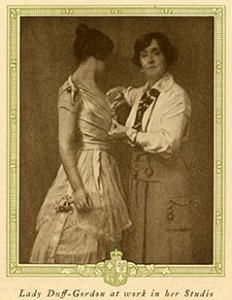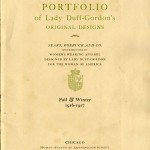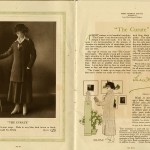 It seems only fitting that the first post of our newly christened blog discuss Lucile, aka Lady Duff-Gordon, the English-born couturière who rose to fame in the early twentieth century. Not only do the lovely muses who grace the top of each page of this blog model her designs, but the ‘Lucile, Lady Duff-Gordon Collection’ (x1) was one of the first designer archives accessioned by the department. The collection contains more than 900 original water color sketches and nearly 2,500 photographs of designs produced by Lucile Ltd. between the years 1915-1925.
It seems only fitting that the first post of our newly christened blog discuss Lucile, aka Lady Duff-Gordon, the English-born couturière who rose to fame in the early twentieth century. Not only do the lovely muses who grace the top of each page of this blog model her designs, but the ‘Lucile, Lady Duff-Gordon Collection’ (x1) was one of the first designer archives accessioned by the department. The collection contains more than 900 original water color sketches and nearly 2,500 photographs of designs produced by Lucile Ltd. between the years 1915-1925.
Professionally known as Lucile, Lady Duff-Gordon was one of the era’s great innovators in the business of fashion. Maison Lucile opened in 1894, and it was not long before the designer’s outspoken, larger-than-life personality and knack for self-promotion captured the attention of the press nearly as often as her designs for romantic chiffon dresses, diaphanous tea gowns, and saucy lingerie. Lucile was one of the first designers to capitalize on celebrity culture, and a consummate provocateur, she gave her creations innuendo-laden names like “Climax” and “The garden of love;” she used mirrored runways so that clients seated closest to the stage caught flashes of reflections up models’ skirts.
These somewhat unorthodox tactics were titillating to a new generation of society ladies and showgirls for whom the subject of sex was not entirely taboo. Lucile’s marriage to her second husband, Sir Cosmo Duff-Gordon, surely smoothed proper society’s acceptance of her risqué antics, while it is through her sister, the novelist and film producer Elinor Glyn, that Lucile had connections to the stage and screen. It is said that Glyn coined the term ‘It Girl,’ and Lucile designed the on and off stage wardrobes for ‘It’ actresses, ingénues and the women of the Ziegfeld Follies.
With the financial backing of Duff-Gordon, Maison Lucile went global; as Lucile Ltd. she expanded to New York in 1909, Paris and Chicago in 1911. In 1916, she pioneered the first diffusion line, partnering with Sears, Roebuck & Co. to create mail order versions of her designs, making her the first couturière to launch a ready-to-wear line.
The Department of Special Collections and FIT Archives is fortunate to act as stewards for one of the largest collections of original Lucile material in the world, including copies of the mail order catalogs for her line offered by Sears, Roebuck & Co. At the time of their creation in 1916 the mail order looks featured in the gallery below retailed for anywhere from $25 to $45, which adjusted for inflation today would be approximately $500 to $900.







10 responses to “Lady Duff-Gordon mail order catalogs, 1916-1917”
Great blog April! Really love it!!
This was fascinating. Please, can the collection be online?
[…] http://blog.fitnyc.edu/materialmode/2013/01/31/lady-duff-gordon-ready-to-wear-catalogs-1916-1917/ […]
I have an original 1917 catalogue from Sears with the Lady Duff-Gordon designs.
It is for sale!
Do you have any idea what the value is of your catalog? I also have a LDG catalog and was trying to figure out the value.
Hi Judi-
I’d contact the lovely gentlemen at Librairie Diktats. They are specialists in this genre. http://www.diktats.com
I have a Lady Duff Gordon original catalog titled “Spring & Summer 1917” in excellent condition. Would love to know the value. Does anyone know how I can Figure this out?
I have a Lady Duff Gordon original catalog titled “Winter & Summer 1916” ı dont know the value, sory for my english, I want to sell it, can anybody help to me maybe??
Dear Izmir,
There has not been a new post here for a very long time, so I don’t know if anyone will see this and answer you. I don’t work at The Museum at FIT, but I saw your question and want to try to help. Can you look on Ebay? Many people use Ebay to see what other people are selling their item for – as an example a copy of a Lucile catalog! If anyone else on Ebay is selling one, you can see how much they sold it for. Kerry Taylor Auctions sold many Lucile single page fashion drawings several years ago. They have an archive site where you can see what these drawings cost at auction. If you contact them they might even be able to answer your question. Any museum in your area that has a costume department may be able to help you. The Smithsonian Institute answers questions too. You might call them. This isn’t much information, but I hope it will be helpful.
Any museum in your area that has a costume department may be able to help you. The Smithsonian Institute answers questions too. You might call them. This isn’t much information, but I hope it will be helpful.
Thanks